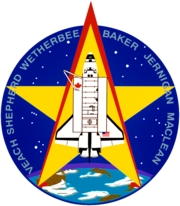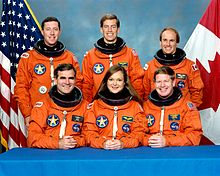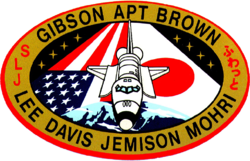STS-52
| STS-52 | |||||
 | |||||
| Uppdrag | 51 | ||||
|---|---|---|---|---|---|
| Rymdfärja | Columbia (13)[1] | ||||
| NSSDC-ID | 1992-070A[2] | ||||
| Färdens tid | 9 dagar, 20 timmar, 56 minuter, 13 sekunder | ||||
| Uppskjutning | |||||
| Startplats | Startplatta 39B vid Kennedy Space Center i Florida | ||||
| Start | 22 oktober 1992, 1:09:39:6433 p.m. EDT | ||||
| Landning | |||||
| Landningsplats | Runway 33, KSC | ||||
| Landning | 1 november 1992, 9:05:53 a.m. EST | ||||
| Omloppsbana | |||||
| Varv | 158 st[3] | ||||
| Apogeum | 307 km | ||||
| Perigeum | 304 km | ||||
| Banlutning | 28,45° | ||||
| Sträcka | 6,645 miljoner km | ||||
| Besättning | |||||
| Befälhavare | James D. Wetherbee (2) | ||||
| Pilot | Michael A. Baker (2) | ||||
| Uppdragsspecialister | Charles L. Veach (2) William M. Shepherd (3) Tamara E. Jernigan (2) | ||||
| Nyttolastspecialister | Steven G. MacLean (1) Kanada | ||||
 | |||||
| Kronologi Rymdfärjeprogrammet | |||||
| |||||
STS-52 var den femtioförsta flygningen i det amerikanska rymdfärjeprogrammet, den trettonde flygningen med rymdfärjan Columbia. Den sköts upp från Pad 39B vid Kennedy Space Center i Florida den 22 oktober 1992. Efter nästan tio dagar i omloppsbana runt jorden återinträdde rymdfärjan i jordens atmosfär och landade vid Kennedy Space Center.
Se även
Referenser
- ^ NASA Space Shuttle Launch Archive Arkiverad 22 april 2012 hämtat från the Wayback Machine., läst 28 juli 2016.
- ^ ”NASA Space Science Data Coordinated Archive” (på engelska). NASA. https://nssdc.gsfc.nasa.gov/nmc/spacecraft/display.action?id=1992-070A. Läst 19 mars 2020.
- ^ Manned Astronautics - Figures & Facts Arkiverad 4 mars 2016 hämtat från the Wayback Machine., läst 28 juli 2016.
Externa länkar
 Wikimedia Commons har media som rör STS-52.
Wikimedia Commons har media som rör STS-52.
| ||||||||
| ||||||||||||||||||||||||||||||||
Media som används på denna webbplats
Five NASA astronauts and one Canadian payload specialist composed the STS-52 crew. Pictured on the back row, left to right, are Michael A. Baker, pilot; James B. Wetherbee, commander; and Steven G. Maclean, payload specialist. On the front row, left to right, are mission specialists Charles (Lacy) Veach, Tamara Jernigan, and William Shepherd. Launched aboard the Space Shuttle Columbia on October 22, 1992 at 1:09:39 p.m. (EDT), the crew's primary objectives were the deployment of the Laser Geodynamic Satellite (LAGEOS II) and operation of the U.S. Microgravity Payload-1 (USMP-1).
Emblem of Nasa's STS-53 mission
- Designed by the crewmembers, the STS-53 insignia shows the Space Shuttle Discovery rising to new achievements as it trails the symbol of the Astronaut Office against a backdrop of the American flag. The five stars and three stripes also serve to symbolize the mission designation (STS-53) and America's continuing commitment to world leadership in space. The pentagonal shape of the patch represents the Department of Defense (DOD) and its support of the Space Shuttle Program. The band delineating the flag from space includes the four colors of the military services of the crewmembers. The names of the flight crewmembers are located along the border of the patch. They are Commander David M. Walker, Pilot Robert D. Cabana, Mission Specialist (MS) Guion S. Bluford, MS James S. Voss, and MS Michael R. U. Clifford. Each crewmember contributed to the design of the insignia.
STS-52 Columbia, Orbiter Vehicle (OV) 102, crew insignia (logo), the Official insignia of the NASA STS-52 mission, features a large gold star to symbolize the crew's mission on the frontiers of space. A gold star is often used to symbolize the frontier period of the American West. The red star in the shape of the Greek letter lambda represents both the laser measurements to be taken from the Laser Geodynamic Satellite (LAGEOS II) and the Lambda Point Experiment, which is part of the United States Microgravity Payload (USMP-1). The LAGEOS II is a joint Italian \ United States (U.S.) satellite project intended to further our understanding of global plate tectonics. The USMP-1 is a microgravity facility which has French and U.S. experiments designed to test the theory of cooperative phase transitions and to study the solid\liquid interface of a metallic alloy in the low gravity environment. The remote manipulator system (RMS) arm and maple leaf are emblematic of the Canadian payload specialist Steven MacLean.
Författare/Upphovsman: Pascal (Flickr user: pasukaru76), Licens: CC0
Vostok spacecraft replica at the Technik Museum Speyer, Germany.
The mission emblem of STS-47 depicts the Space Shuttle Orbiter with the Spacelab module in the cargo bay against a backdrop of the flags of the United States and Japan, symbolizing the side-by-side cooperation of the two nations in this mission. The land masses of Japan and Alaska are represented on the emblem emphasizing the multi-national aspect of the flight as well as the high inclination orbit of 57 degrees. The initials `SLJ' on the left border of the emblem stand for Spacelab Japan, but the name generally used for the mission is `Spacelab-J.' The Japanese characters on the right border form the word `Fuwatto' which is the Japanese word for weightlessness.






